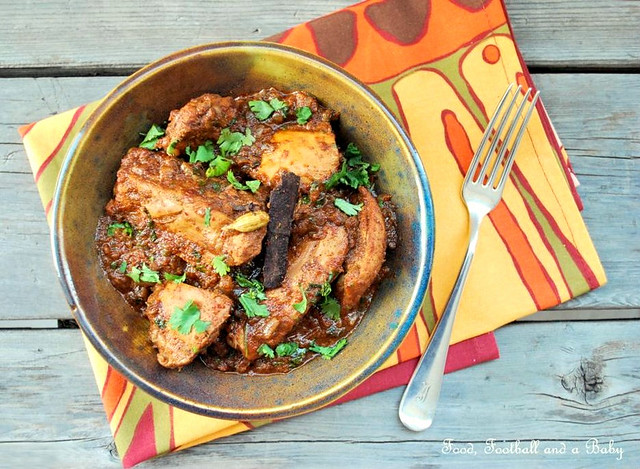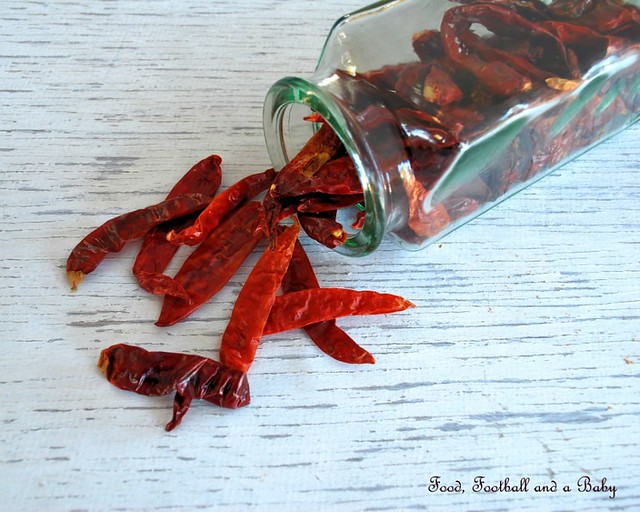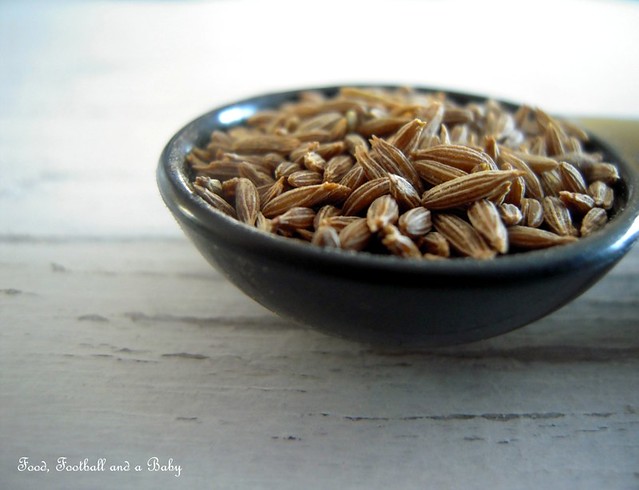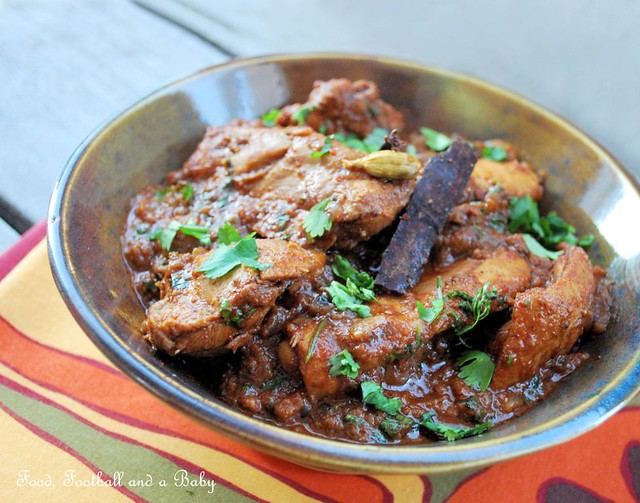This is a long post, so grab yourself a glass of your favourite tipple, and come join me on a voyage of discovery, from Goa to Mangalore to England, all via a dish called a vindaloo.
First off, confession time. I hadn't thought of chicken vindaloo for the longest of times. Not sure why, really, because I sure loved this dish when I was growing up. I was reminded of it again, when one of my students requested that I teach him how to make this dish. Which then made me wonder why on earth hadn't I blogged about it, since its a South Indian (and British, haha) classic.
First off, confession time. I hadn't thought of chicken vindaloo for the longest of times. Not sure why, really, because I sure loved this dish when I was growing up. I was reminded of it again, when one of my students requested that I teach him how to make this dish. Which then made me wonder why on earth hadn't I blogged about it, since its a South Indian (and British, haha) classic.
Vindalho de galinha, or chicken vindaloo, as its commonly known, is a fiery, tangy and hot dish, with a slight edge of sweetness that gives it a beautiful balance of flavours. The dish hails from the tiny state of Goa in South India. Goa is India's smallest state, and was a colony of Portugal until taken over by India in 1961. The state is still awash with its colonial history, and elements of Portuguese culture are everywhere, from the food, to religion, to architecture and language.
Being a Mangalorean Catholic myself, we are a community that are closely aligned with Goan culture, especially religiously. Mangaloreans speak Konkani, which is the state language of Goa, albeit in a different dialect. We also share a lot of cultural markers, including our names. I have several relatives with Portuguese names like Fernandes, Da Cruz, Da Costa and Rodrigues. My mother herself was a Da Silva before marriage. I get a lot of people asking me is Michelle is my real name, and I have to explain that yes, it is, and yes, my maiden name was Peters, until I married this Jones fellow. Its not unusual for Mangalorean Catholics and Goans to have very Western names.
Along with culture, the other important element that we share with Goa is the food. Mangaloroeans, like Goans, love their spicy hot meat dishes. Hot red chillies give our sauces their characteristic red colour, while a liberal use of vinegar (and ocasionally, tamarind) give them a delicate tanginess, that is associated heavily with Goan dishes. The use of tomatoes in sauces is relatively rare, and the thick sauces are a result of slow cooking the dishes, which encourage meats to release their juices and make a natural stock and spice based gravy.
There is usually a lot of confusion about the use of the word 'aloo' in vindaloo. As 'aloo' means potato in Hindi, this leads quite a lot of people to believe that a vindaloo has potatoes in it, which is actually not the case at all. The word 'vindaloo' is a corruption of 'vindalho' that usually referes to a dish cooked with spices and a good slug of vinegar. My research around this dish has suggested that a Goan vindalho is an Indian adaptation of the Portuguese dish 'Carne de Vinha d' Alhos' (meat with wine and garlic) And the list of ingredients in a classic vindalho certainly lends credence to this suggestion. Quite a lot of Goan dishes have been adapted from Portuguese ones, particularly meat and fish.
So, its not unusual to find caldeiradas, empadinhas, bacalhaus and assados in Goan cuisine. The Indian side offers the rich collection of local spices that go into making these dishes uniquely Goan. Goan food is, therefore, a very unusual mixture of local and foreign, and a true amalgamation of two diverse cultures.
Strictly speaking, vindalhos are made with pork and it will be unusual to find them made with chicken in Goa. The book from which I adapted this recipe, an absolutely fantastic collection of Goan recipes by Maria Teresa Menezes, speaks of the vindalho as almost being 'pickle like' and a dish that was usually carried by travellers due to its ability to stay unspoilt. This is achieved by the liberal use of vinegar, and a long slow cooking process. It is, in many ways, very similar to the Mangalorean pork indad, except that it doesn't use rum or mint.
In British cuisine, however, a vindaloo has now come to refer to a hot curry, and these dishes are made with a wide variety of meats and fish. For this particular class, I wanted to demonstrate a more authentic vindalho, so I adapted Maria's 'Vindalho de Porco' recipe. It is still an adapted dish, as I significantly reduced down the number of red chillies, which meant that the dish was not super spicy. I kept the method of cooking fairly authentic, while playing around with the ingredients to suit my student and myself, and taking advantage of some of the ingredients available to me.
A few of the changes I made are listed below.
So, its not unusual to find caldeiradas, empadinhas, bacalhaus and assados in Goan cuisine. The Indian side offers the rich collection of local spices that go into making these dishes uniquely Goan. Goan food is, therefore, a very unusual mixture of local and foreign, and a true amalgamation of two diverse cultures.
Strictly speaking, vindalhos are made with pork and it will be unusual to find them made with chicken in Goa. The book from which I adapted this recipe, an absolutely fantastic collection of Goan recipes by Maria Teresa Menezes, speaks of the vindalho as almost being 'pickle like' and a dish that was usually carried by travellers due to its ability to stay unspoilt. This is achieved by the liberal use of vinegar, and a long slow cooking process. It is, in many ways, very similar to the Mangalorean pork indad, except that it doesn't use rum or mint.
In British cuisine, however, a vindaloo has now come to refer to a hot curry, and these dishes are made with a wide variety of meats and fish. For this particular class, I wanted to demonstrate a more authentic vindalho, so I adapted Maria's 'Vindalho de Porco' recipe. It is still an adapted dish, as I significantly reduced down the number of red chillies, which meant that the dish was not super spicy. I kept the method of cooking fairly authentic, while playing around with the ingredients to suit my student and myself, and taking advantage of some of the ingredients available to me.
A few of the changes I made are listed below.
- Obviously, I used chicken instead of pork, though now that I have tasted this dish I am definitely going to try out the pork version too.
- I used a red wine vinegar, as I was curious to know how the dish would taste with a 'winier' flavour. Normally it is made with plain distilled white vinegar. The result? Not very different from vindalhos made with the plain vinegar, but I did detect a slightly fruitier edge to the dish, and it also didn't have a strong vinegary taste to it.
- I actually prefer tasting a spice flavour rather than recieving a blast of pure heat from my Indian dishes. Yes, I know I am turning into a chicken, but come on... wouldn't you rather taste the myriad flavours of the dish, rather than spend your time in a glass of water? So I reduced down the number of red chillies, and also made this dish with the milder Kashmiri chilly, rather than the much hotter 'byadgi' chilly. The Kashmiri chillies added a stunning red colour to the dish, though I will also admit to using a tablespoon of mild paprika to enhance the colour a bit. If you want to make this dish spicier, I suggest increasing the number of chillies, and also tossing in a teaspoon or so of hot chilli powder to add the kick. Mind you, this will make the dish really hot, so you've been warned.
- There are two schools of thought with this dish. The first one prefers a smooth sauce, so grinds down the fried onions with the ginger and garlic to make a smooth paste, in which the chicken is cooked. The other, namely me, prefers a little more texture to the dish, so instead of grinding the onion down, I just dice it very fine, and fry in a mixture of oil and ghee. Maria, in her recipe, actually marinates her pork with the finely diced onion, and then cooks it all together, so this is not that unusual a preference. The onions add a little more textural interest to the dish, but do feel free to go with whatever you like.
- After cooking the dish and tasting it, I felt it just needed a tiny extra something to really elevate it, so I added a teaspoon of sugar. It made a huge difference to the dish and added a really subtle edge of sweetness to it, nothing overwhelming or taking away from the spiciness, rather just enhancing the taste in an easy delicate way instead.
- And finally, please do not add potatoes to this dish. There are tons of chicken with potato curries in Managalorean and Goan cuisine, but this is not one of them. Potatoes actually absorb the spice and salt that make this dish unique, and actually don't add that much in terms of flavour or interest to the dish. If you must have potatoes, make sure they are shallow fried until golden, and served on the side, rather than mixed in with the sauce.
Recipe:
½ kilo chicken thighs, cut into two pieces each (depending on how big they are)
Spice Mix6 long red chillies
2 inch cinnamon stick
1 tsp whole cumin seeds
1/4 tsp whole peppercorns
1/8 tsp whole fenugreek seeds
1 dry bay leaf
Marinade
3½ tbsp red wine vinegar or plain white vinegar
4 garlic cloves, crushed
2 inch piece of ginger, grated
1 tbsp mild paprika
½ tsp turmeric
½ tsp hot chilli powder (optional, use only if you like your curries really hot)
1½ tsp salt
Rest of the dish1 medium onion, diced fine
1 inch stick of cinnamon
2 - 3 whole cloves
2 - 3 pods of green cardamom, left whole
3 garlic cloves, crushed
1 tsp sugar
1 inch piece of ginger, grated
1 tbsp olive oil
½ tbsp ghee (optional, if not using, increase oil to 2 tbsp)
Fresh cilantro, to garnish
Method:
To make the spice mix - toast together the ingredients in a heavy pan, for about 1 minute, stirring constantly, until fragrant and the spices have darkened a little bit. Let cool, then grind to a fine powder using a spice grinder, and keep aside.
To make the marinade, place the above spice mix in a bowl. Add the grated ginger and garlic, vinegar, turmeric, paprika and salt. Taste and add a little more salt and/ or vinegar, if required.
Rub the marinade into the chicken pieces, and refrigerate for at least 4 hours (preferably overnight)
Once the chicken has been marinated, heat the oil and the ghee together in a heavy pot. Add the diced onion, along with the whole cinnamon, cloves and cardamom. Fry the onion for at least 10 minutes on a medium-high heat, until very soft and golden. Add the grated ginger and garlic, then cook for an additional minute. Turn down the heat to medium-low.
Add the chicken, marinade and all to the pot. Stir well until the chicken is well coated with the onion-ginger-garlic and the whole spices. Add the sugar and stir.
Cover the pot with a lid, and let the chicken cook for about 15 - 30 minutes (depending on the thickness of the pieces), stirring every so often, until the chicken is cooked all the way through and tender. During this slow cooking period, the chicken will release its juices to make a thick and rich sauce. Taste, and adjust the seasoning, if required.
Take the vindalho off the heat, and stir in the fresh, chopped coriander. Serve hot with rice or naan or roti.














I love authentic vindaloos like this one. I make a similar one at home with pork but have never risked getting a Vindaloo takeaway. I'm scared of what I might end up with!
ReplyDeleteCorina, thank you. I only ate one vindaloo when I lived in England, and vowed never to repeat the experience. All I could taste was tomato paste and hot chilli powder.
ReplyDeleteActually yours would be the authentic one, as Goans always make their vindalhos with pork, and very rarely with chicken.
This looks mouth watering Michelle - and I have all the ingredients in my pantry/fridge/freezer. I think I know what we're eating one night this week!
ReplyDeleteThanks Nicola. Yes, it did turn out pretty delicious. If you are using Kashmiri or mild chillies, I suggest keeping the spice level the same. Otherwise you could tinker to make it a little less spicy. Either way, its great with a naan or a roti.
ReplyDeleteLooks great! I have been looking for a vindaloo recipe..thx for sharing!
ReplyDeleteI love learning about the history of a dish - the vindaloo looks gorgeous too!
ReplyDeleteThank you Asiya, it is a pretty foolproof dish, as all Maria's recipes are.
ReplyDeleteMimi, I was a bit shocked when I frist tried vindaloo in England, it tasted like chili powder in tomato sauce :-) A lot of Goan dishes have so much hitory to them, I should do such recipes more often.
Now this is a seminar about vindaloo! Never hears of it before, but it looks delicious! I'll make a try..
ReplyDeleteHave a nice day!
Great article and wonderfully looking recipe! THX
ReplyDeleteThanks Eri. My lecturing background comes in quite nady for these posts, I've found. I think you'll really enjoy this, please let me know how it goes.
ReplyDeleteAZA, thank you, and I hope you make and enjoy the recipe.
Wonderful history - and I have to tell you this looks simply delicious - I would LOVE to eat this - I will make it - I'm not sure it will turn out like yours but I will try cause it looks SOOOOOOOO fantastic :)
ReplyDeleteMary x
Mary, you'll actually be surprised at how easy this dish is to out together. The hardest part is getting everything together and marinating the chicken. I think you'll love this dish, and the flavours are very similar to the Moroccan lamb you posted.
ReplyDeleteHi,
ReplyDeleteI cooked this yesterday and it came out bloody gorgeous! It was busrting with flavor! And my girlfriend loved it too.Im already looking forward to do it again LOL.
Picture Here
AZA, wow... thank you. Am so glad you liked it. Its such a thrill and a real adrenaline rush when someone actually makes a recipe and likes it too, and I love that picture. Would you mind if I shared it on my blog's Facebook page?
ReplyDeleteMichelle: Of course I dont mind :-)
ReplyDeleteHi Michelle, just loved your chettinad and this is first time I tried Vindaloo, did not eat it as yet but aroma and the taste is just awesome. Keep up all good cooking and I will be trying more of it from your blog :)
ReplyDeleteI made this with a beef roast in the crockpot and it was amazing. I subbed some of the spices with ground instead though (Call me lazy). The whole family loved it. I love how naturally sweet the recipe is with only one mere tsp of sugar. Your recipes are perfection as usual!
ReplyDeleteHi Michelle,
ReplyDeleteThis is my forst time visiting your blog. Loved reading your post. I totally agree with you, there are so many misleading vindaloo recipes. I wrote very similar things on my blog too.
happy blogging.
Soma
I am Portuguese and am just fascinated by this post, in particular the whole background you provide. I didn't even know that vindaloo existed until I read this.
ReplyDeleteThe original vinha d'alhos with pork, wine, lots of garlic, bay leaves and paprika has been one of my favorites. It is mostly cooked as barbecue, almost like souvlaki. I will certainly try this, it resembles another Portuguese dish : piri-piri chicken (frango com piri piri).
Diego
Authentically you should add Goan vinegar to it
ReplyDeletei just finished making!! and its lovely!! love the flavoursthe spices!!yummmmyyy!! wil be making this often..thanks a lot...do keep posting more of chicken specialities..thank you
ReplyDeletenothing to do on a lazy saturday afternoon. . . went to the supermarket and bought all the spices, spent hours preparing it, marinading it, cooking it slowly. . . .just finished eating it and it was well worth the effort. It was absolutely excellent, the nicest curry I've ever had, and I've had loads. Thank you very much for posting the recipe!!!
ReplyDeleteUK
This looks deicious, perfect for a cold February night's meal
ReplyDeleteFound this recipe while searching for potato vindhaloo. Tried it. You have compiled an incredibly tasty spice fusion.awesome job Michelle. I forwarded the link to all my friends.we in kerala traditionally add ground mustard to the marinade for pork vindhaloo.
ReplyDeleteKeep posting great recipes.
been looking for a nice recipe of this to try. Thanks for sharing this.
ReplyDeleteSimon
It must just be too early for me, but what do you do with the grinded spice mix?
ReplyDeleteI have never eaten this dish before nor do i know how to make it but after reading this i want to make this but why havent you added tomatoes as i read on some other bloggers post adding tomatoes?
ReplyDeleteMaybe the tomatoes' acidity would make the chicken tough?
DeleteReally interesting, we've never actually had chicken in a vindaloo before, as the article says, we always have pork. Being in Australia, I've actually had it with hogget/mutton (the sheep kind, not the goat kind) but we soaked that in the masaala the day before. We cooked it a long time, and it came out pretty good.
ReplyDeleteI must try this recipe though, because I was worried that the acidity of a vindaloo would make the chicken tough.
Hello Michelle,
ReplyDeleteI've tried your recipe with pork today and it is great. I'll definitely be making it again soon. Thank you for the very insightful recipes.
Regards
Sasha Stjepanovic, Brisbane Australia
Hi Michelle,
ReplyDeleteWe made your recipe with pork today and it was great. Looking forward to making it soon again. Thank you for the insightful recipes.
Hi Michelle, is there any way I can adapt this into a simmering recipe for beef vindaloo? I was thinking of adding some tomato sauce and baking in the oven for an hour or two. Julie
ReplyDeleteHi Michelle,
ReplyDeleteI am thinking of adapting this recipe for beef! I was thinking of adding some tomato sauce and stewing in the oven for an hour or 2. Do you have any suggestions?
Julie